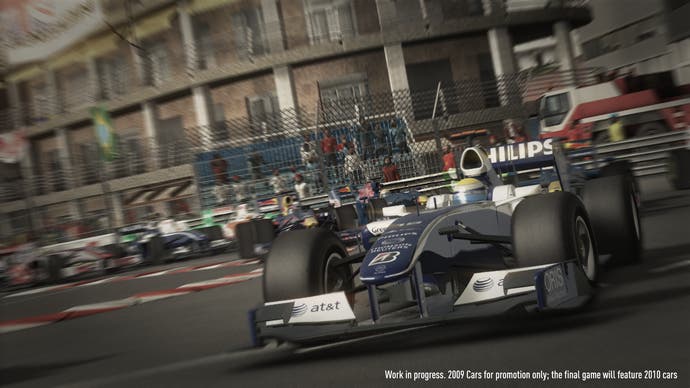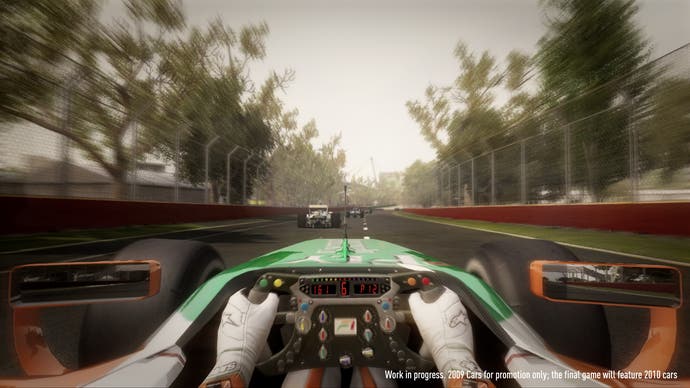F1 2010
Candid camber.
"The car's the star." It's the oft-quoted cliché of the automotive industry and often applied to racing games too, aptly so in the case of a Forza Motorsport or a Gran Turismo. The sprawling interactive car catalogues that dominate the serious end of racing games lavish polygons on photo-realistic car models and processing power on simulating every pitch and twitch of their handling characteristics, often to the exclusion of all else (including damage modelling and the intelligence of your opponents).
When it comes to Formula One, the pinnacle of motor sport, however, the car will never be the star, no matter how much its detractors claim that it's all about the hardware these days. In Formula One, the rivalries, fragile egos and contractual machinations of the star drivers grab the headlines and write the true story of the season, and that's especially true this year, with four world champions in the field, two of them British and in the same team, one of them a seven-time legend returning from retirement, haunted by the spectre of irrelevance. As sleek and technocratic as it is, Formula One is still a sport, and sport is still a dirty, human business.
Codemasters understands this well. Once we learned that the publisher, with its specialist Racing Studio, had snagged the F1 rights, a competent and graphically impressive rendition of the on-track action was almost a given. This, after all, is the outfit that has turned out great racing game after great racing game using the excellent EGO engine, and last year's Wii taster made in conjunction with Sumo did nothing to dissuade us.

What we didn't necessarily expect, and what Codemasters has just revealed this week, was an involved and innovative career mode that makes you, the driver, as much of a star as the car. Aiming to simulate the intrigue and rivalry of the Formula One paddock, it can accommodate dynamic objectives, shifting team fortunes, team-mate relationships, championship rivalries, in-season and out-of-season R&D, contract negotiations and even media interviews. It's what makes F1 2010 not just, potentially, the best F1 game in years, but one of the most interesting racing games of any stripe in development right now.
We'll get to that shortly. But, sinking down into a bucket seat and racing wheel arrangement for a few laps of Monza in a Red Bull, it's neither the car nor the driver that seems the immediate star of F1 2010; it's the tyres, or maybe the weather. EGO has always excelled at tangible textures and particle effects and the result is a simply stunning-looking racing game.
Whichever camera you use - they're all good, but I favoured the third-person cockpit view, TV coverage style, showing my driver's helmet bobbing and twisting under G-forces - the visible and highly realistic changes to your tyres as they wear down or pick up dirt immediately put you closer to the tarmac than any previous F1 game has managed, as well as offering some useful visual feedback on grip. Rainy conditions are astonishingly immersive, fountains of spray rising from the cars and spattering the camera while the cars's full wet tyres leave carve lines of dry asphalt through the standing water.

The handling is unsurprisingly twitchy and takes a little getting used to after months of the hefty-yet-supple Forza 3; you need to brake very early and be gentle with the wheel and throttle, as the Red Bull needs almost no provocation to spin out. It's not impossible to get things under control in five minutes with all the assists turned off, although a decent lap time is still a distant dream.
The team is keen to avoid talk of either "arcade" or "simulation" handling, preferring to use words like "authentic", "predictable" and "consistent". That could be because DiRT and GRID's lighter handling styles have disappointed sim fans, and Racing Studio is keen to extract itself from a debate you can't win. But it's also fair; making something as incomprehensibly fast, agile and volatile as an F1 both driveable and involving is no mean feat, and based on a short play-test this handling scheme seems well up to the task.


